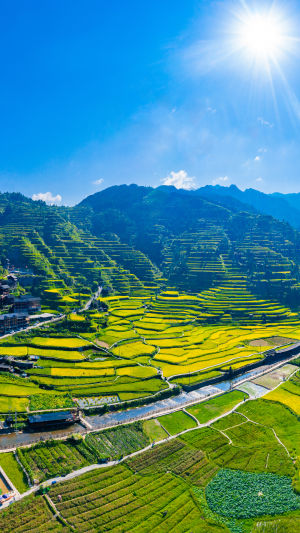Terraces, cultivated steps, or platforms on sloping land are a testament to human ingenuity and a timeless solution to maximizing agricultural productivity in challenging landscapes.
These man-made formations not only serve functional purposes but also give rise to breathtaking landscapes and hold significant cultural value in various parts of the world.
In this article, we'll delve into the world of terraces, exploring their history, purpose, and the remarkable beauty they bring to both rural and urban environments.
1. A Landscape Transformation
Origins: Terracing has ancient origins, dating back thousands of years to civilizations like the Inca, Aztec, and ancient Chinese. It emerged as a response to the necessity of optimizing land utilization in regions characterized by hilly or mountainous terrain.
2. Agricultural Advantages
Erosion Control: Terraces are highly effective in preventing soil erosion, as they slow down and redirect water flow, reducing the loss of fertile topsoil.
Irrigation: Terraces often include systems for channeling and distributing water, making them ideal for rice paddies and other crops that require precise water management.
Microclimates: The varied elevations of terraces create microclimates, allowing farmers to cultivate a wider range of crops.
3. Remarkable Landscapes
Aesthetic Appeal: Terraced landscapes, with their symmetrical and often picturesque arrangements, create stunning vistas that draw tourists and photographers.
Scenic Beauty: The lush greenery of terraced fields against the backdrop of mountains or hills is a sight to behold, making these landscapes popular tourist destinations.
4. Global Cultural Significance
Rice Terraces of the Philippine Cordilleras: A UNESCO World Heritage site, these terraces showcase the Ifugao people's sustainable agricultural practices.
Machu Picchu, Peru: The terraced agricultural fields surrounding this Inca citadel are renowned for their structural precision and stunning location.
Banaue Rice Terraces, Philippines: Often referred to as the "Eighth Wonder of the World," these terraces are a cultural treasure.
Yunnan Hani Rice Terraces, China: A masterpiece of land management, this UNESCO World Heritage site reflects the deep connection between the Hani people and their environment.
5. Urban Terracing
Modern Architecture: Terracing has transcended agriculture and is now an architectural concept in cities. Buildings with stepped, garden-adorned terraces offer residents a connection to nature.
Urban Farming: Rooftop and balcony gardens in urban areas use terracing principles for efficient space utilization.
6. Challenges and Sustainability
Maintenance: Maintaining traditional terraces can be labor-intensive, and with changing demographics, some face the risk of abandonment.
Modernization: In some cases, terraces are being modernized with mechanization and new irrigation systems to enhance efficiency.
7. The Future of Terraces
Sustainable Agriculture: Terraces continue to be essential for sustainable farming practices, particularly in regions with challenging topography.
Climate Resilience: As climate change brings more intense rainfall and flooding, terraces play a critical role in mitigating soil erosion.
8. Recreational and Cultural Use
Tourism: Terraced landscapes attract visitors for their beauty and cultural significance. They are often destinations for trekking, photography, and cultural experiences.
Cultural Heritage: Terraces are not just functional; they are an integral part of the cultural heritage of many communities, passed down through generations.
9. Environmental Benefits
Biodiversity: Terraced landscapes often host diverse ecosystems, providing habitat for various plant and animal species.
Carbon Sequestration: These landscapes can help store carbon, contributing to climate change mitigation.
10. Erosion Control and Disaster Prevention
Natural Barriers: Terraces serve as natural barriers against landslides and mudslides, protecting communities and infrastructure downhill.
Water Management: The step-like design of terraces helps manage heavy rainfall, reducing the risk of flooding in vulnerable areas.
Terraces are a remarkable testament to human adaptation and the synergy between agriculture and nature. They offer numerous advantages, from preventing soil erosion to creating stunning landscapes and fostering cultural identity.
As we face environmental challenges, the sustainable and resilient practices embodied by terraces become increasingly relevant.
Whether in rural fields or on the rooftops of urban skyscrapers, terraces continue to be both functional and beautiful, a living testament to human creativity and our connection to the land.





